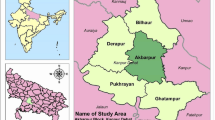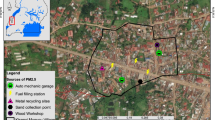Abstract
Household air pollution from biomass fuel is a main cause of health problem in Ethiopia, since 93% of households use solid fuel for cooking. Household air pollution studies are limited in Ethiopia. Therefore, we attempted to determine the level of household fine particulate matter concentrations from cooking fuels in Wolaita Sodo town, Ethiopia. A cross-sectional study design was used to measure particulate matter (PM2.5) in 109 kitchens in randomly selected households. The University of California Berkeley particle monitor data logger devices were used for measuring the level of PM2.5 for the duration of 24 h based on the installation protocol. Descriptive statistics were used to evaluate the variation across fuel sources. Out of 109 households, 83 (76.15%) and 26 (23.85%) used predominately biomass fuel and mixed types fuel sources for cooking respectively. The overall geometric mean of PM2.5 was 413.27 μg/m3. The magnitude of PM2.5 from biomass fuel source was a mean (SD) of 926.34 μg/m3(899.00), followed by mixed type of fuel users, 279.42 μg/m3 (216.71). The median concentration of PM2.5 in all monitored households was 412.55 μg/m3. One-way ANOVA between fuel types was found to be statistically significant resulted in different mean concentration of particulate matter for both types of fuels used in households [P < 0.001]. PM2.5 was higher than the World Health Organization air quality guideline value. Therefore, supplying improved cook stoves and clean fuel sources is decisive intervention.


Similar content being viewed by others
References
Admasie A, Kumie A, Worku A (2018a) Association of household fuel type, kitchen characteristics and house structure with child size at birth in Wolaita Sodo, Southern Ethiopia. Open Public Health J 11:298–308. https://doi.org/10.2174/1874944501811010298
Admasie A, Kumie A, Worku A (2018b) Children under five from houses of unclean fuel sources and poorly ventilated houses have higher odds of suffering from acute respiratory infection in Wolaita-Sodo, Southern Ethiopia: a case-control study. J Environ Public Health 2018:9–9. https://doi.org/10.1155/2018/9320603
Arnez CA, Edwards Rufus D, Michael J, Miriam Z, Leonora R, Díaz JR et al (2008) Reduction in personal exposures to particulate matter and carbon monoxide as a result of the installation of a Patsari improved cook stove in Michoacan Mexico. Indoor Air 18(2):93–105
Balakrishnan K, Ramaswamy P, Sambandam S, Thangavel G, Ghosh S, Johnson P et al (2011) Air pollution from household solid fuel combustion in India: an overview of exposure and health related information to inform health research priorities. Glob Health Action 4(5638):5638. https://doi.org/10.3402/gha.v4i0.5638
Balakrishnan K, Ghosh S, Ganguli B, Sambandam S, Bruce N, Barnes DF, Smith KR (2013) State and national household concentrations of PM2.5 from solid cookfuel use: results from measurements and modeling in India for estimation of the global burden of disease. Environ Health Perspect 12(77). https://doi.org/10.1186/1476-069X-12-77
Bartington SE, Bakolis I, Devakumar D, Kurmi OP, Gulliver J, Chaube G et al (2017) Patterns of domestic exposure to carbon monoxide and particulate matter in households using biomass fuel in Janakpur, Nepal. Environ Pollut (Barking, Essex : 1987) 220(Pt A):38–45. https://doi.org/10.1016/j.envpol.2016.08.074
Central Statistical Agency (2018) Recent survey releases: new towns population projection. Central Statistical Agency, Addis Ababa, Ethiopia
Dionisio KL, Stephen RCH, Dominici F, Fornace KM, Spengler JD, Donkor S et al (2012a) The exposure of infants and children to carbon monoxide from biomass fuels in The Gambia: a measurement and modeling study. J Expo Sci Environ Epidemiol 22:173–181. https://doi.org/10.1038/jes.2011.47
Dionisio KL, Howie SRC, Ezzati M (2012b) Household concentrations and exposure of children to particulate matter from biomass fuels in The Gambia. Environ Sci Technol 46(6):3519–3527
Helen GS, Aguilar-Villalobos M, Adetona O, Cassidy B, Bayer CW, Hendry R et al (2015) Exposure of pregnant women to cookstove-related household air pollution in urban and Periurban Trujillo, Peru. Arch Environ Occup Health 70(1):10–18. https://doi.org/10.1080/19338244.2013.807761
Jodeh S, Hasan AR, Amarah J, Judeh F, Salghi R, Lgaz H, Jodeh W (2018) Indoor and outdoor air quality analysis for the city of Nablus in Palestine: seasonal trends of PM10, PM5.0, PM2.5, and PM1.0 of residential homes. Air Qual Atmos Health 11(2):229–237
Johnson M, Lam N, Brant S, Gray C, Pennise D (2011) Modeling indoor air pollution from cookstove emissions in developing countries using a Monte Carlo single-box model. Atmos Environ 45:3237–3243
Joon V, Kumari H, & Chandra A (2011) Predicting exposure levels of respirable particulate matter (PM2.5) and carbon monoxide for the cook from combustion of cooking fuels. Paper presented at the International Conference on Chemistry and Chemical Process, Singapore
Kumie A, Emmelin A, Wahlberg S, Berhane Y, Ali A, Mekonnen E, Brandstrom D (2009) Magnitude of indoor NO2 from biomass fuels in rural settings of Ethiopia. Indoor Air 19(1):14–21. https://doi.org/10.1111/j.1600-0668.2008.00555.x
Legros G, Havet I, Bruce N, & Bonjour S (2009) The energy access situation in developing countries: a review focused on least developed countries and sub-Saharan Africa. Nairobi, Kenya
Megan G (2011) Mixed methods approach to assessing indoor air pollution among women in Addis Ababa. (Master of Public Health in Global Health), Emory University, Atlanta. Retrieved from https://legacy-etd.library.emory.edu/view/record/pid/emory:93n41
Mukhopadhyay R, Sambandam S, Pillarisetti A, Jack D, Mukhopadhyay K, Balakrishnan K et al (2012) Cooking practices, air quality, and the acceptability of advanced cookstoves in Haryana, India: an exploratory study to inform large-scale interventions. Glob Health Action 5:1–13. https://doi.org/10.3402/gha.v5i0.19016
Oluwole O, Ana GR, Arinola GO, Wiskel T, Falusi AG, Huo D et al (2013) Effect of stove intervention on household air pollution and the respiratory health of women and children in rural Nigeria. Air Qual Atmos Health 6(3):553–561
Pennise D, Brant S, Agbeve SM, Quaye W, Mengesha F, Tadele W, Wofchuck T (2009) Indoor air quality impacts of an improved wood stove in Ghana and an ethanol stove in Ethiopia. Energy Sustain Dev 13:71–76
Ranabhat CL, Kim C-B, Kim C-S, Jha N, Deepak KC, Connel FA (2015) Consequence of indoor air pollution in rural area of Nepal: a simplified measurement approach. Front Public Health 3:5. https://doi.org/10.3389/fpubh.2015.00005
Sanbata H, Asfaw A, Kumie A (2014a) Association of biomass fuel use with acute respiratory infections among under- five children in a slum urban of Addis Ababa, Ethiopia. BMC Public Health 14:1122. https://doi.org/10.1186/1471-2458-14-1122
Sanbata H, Asfaw A, & Kumie A (2014b) Indoor air pollution in slum neighbourhoods of Addis Ababa, Ethiopia. Indoor air pollution (IAP) updates from the WASHplus Project. Atmospheric environment
Smith KR (2010) Development of the UCB-L particle monitor: for future California applications in environmental justice; School of Public Health University of California Berkeley, Prepared for the California Air Resources Board and the California Environmental Protection Agency
Tafese T, Tamre B (2015) Household energy choice and demand in urban Ethiopia: case of Wolaita zone. Int J Res Commer Econ Manag 5(11):5–10
Tong X, Wang B, Dai W-T, Cao J-J, Ho SSH, Kwok TCY et al (2018) Indoor air pollutant exposure and determinant factors controlling household air quality for elderly people in Hong Kong. Air Qual Atmos Health 11(6):695–704
University of California Berkeley (2005) Standard operating procedure installing indoor air pollution instruments in a home (Vol. Version 5.1). University of California Berkeley: Indoor Air Pollution Team and Center for Entrepreneurship in International Health and Development (CEIHD) School of public health, University of California Berkeley
University of California-Berkeley (2005) UCB Particle Monitor Protocol (October 2005) Standard Operating Procedure UCB Particle Monitor (Collection, Downloading, and Storage of Data) Version 5.1 (October 2005), Indoor Air Pollution Team and Center for Entrepreneurship in International Health and Development (CEIHD) School of Public Health, University of California-Berkeley USA. University of California, Berkeley USA: Berkeley Air Monitoring Group and Indoor Air Pollution Team School of Public Health, University of California, Berkeley USA
Van Vliet ED, Asante K, Jack DW, Kinney PL, Whyatt RM, Chillrud SN et al (2013) Personal exposures to fine particulate matter and black carbon in households cooking with biomass fuels in rural Ghana. Environ Res 127:40–48
WHO (2005) WHO air quality guidelines global update 2005 report on a working group meeting, Bonn, Germany, 18–20 October 2005: World Health Organization
WHO (2006) WHO Air quality guidelines global update 2005: particulate matter, ozone, nitrogen dioxide and sulfur dioxide. Copenhagen: World Health Organization, Regional Office for Europe; 2006
WHO (2018) Household air pollution and health. 8 May 2018. from http://www.who.int/news-room/fact-sheets/detail/household-air-pollution-and-health
Wolaita Zone Health Bureau (2016) Wolaita zone health bureau annual report. Wolaita Sodo, Ethiopia: Wolaita zone Health Bureau
Acknowledgments
We would like to thank Wolaita Sodo University and Addis Ababa University for financial support. We would like to thank also Wolaita Sodo town administration and study participants for giving us their time and allowing us to undertake data collection. Special thanks goes to Gaia Association, Ethiopia for providing HAP monitoring devices. We are also grateful to data collectors and supervisor for maintaining data quality.
Author information
Authors and Affiliations
Contributions
AA carried out protocol development, data collection, data management and analyses, and writing the manuscript. AK and AW were involved in protocol development, providing field work monitoring, and editing the manuscript. WT was involved on technical support of monitoring devices and editing manuscript. All authors read and approved the manuscript.
Corresponding author
Ethics declarations
Ethical approval and consent to participate
Ethical clearance to undertake the study was obtained from Addis Ababa University, College of Health Sciences-Institutional Review Board Office. Informed consent to participate in the study was obtained. For this, subject information sheet and informed consent letter were attached to each questionnaire. Participants were informed that participating is voluntarily and has no risk or harm. The right of the respondent to withdraw from the interview or not to participate was respected. For those houses with poorly ventilated houses and biomass-dependent households were informed about the health risks of poor house ventilation and biomass fuel use.
Competing interests
The authors declare that they have no conflict of interest.
Additional information
Publisher’s note
Springer Nature remains neutral with regard to jurisdictional claims in published maps and institutional affiliations.
Rights and permissions
About this article
Cite this article
Admasie, A., Kumie, A., Worku, A. et al. Household fine particulate matter (PM2.5) concentrations from cooking fuels: the case in an urban setting, Wolaita Sodo, Ethiopia. Air Qual Atmos Health 12, 755–763 (2019). https://doi.org/10.1007/s11869-019-00700-0
Received:
Accepted:
Published:
Issue Date:
DOI: https://doi.org/10.1007/s11869-019-00700-0




